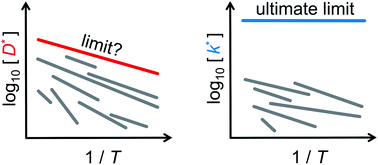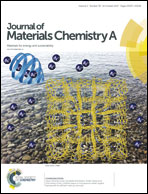Limits to the rate of oxygen transport in mixed-conducting oxides
Abstract
The processes of oxygen tracer diffusion and oxygen surface exchange in acceptor-doped oxides displaying high rates of oxygen transport are examined. Literature data are analysed with the standard atomistic expression, in order to obtain chemically reasonable limiting values for the oxygen diffusion coefficient, D*, in the solid state. The analysis suggests a limiting value of D* that is characterised by a pre-exponential of 8.8 × 10−2 cm2 s−1 and an activation enthalpy of 0.5 eV. An (essentially temperature-independent) ultimate limit to the oxygen surface exchange coefficient, k*, of ca. 100 cm s−1 is obtained by assuming surface exchange to be limited by the incident flux of oxygen molecules from the gas phase. In addition, atomistic expressions are derived that quantitatively describe experimental k* data as a function of temperature and oxygen activity for surface exchange involving molecular oxygen at high temperatures. One expression is found for oxides with a bandgap, such as SrTiO3, Ce0.9Gd0.1O1.95, and La0.6Sr0.4Fe0.8Co0.2O3−δ; and an analogous expression is found for oxides with a partially filled conduction band, such as La1−aSraCoO3−δ and (Ba0.5Sr0.5)(Co0.8Fe0.2)O3−δ. Conduction-band electrons are considered for both types of oxides to play a central role in determining the rate of oxygen surface exchange.



 Please wait while we load your content...
Please wait while we load your content...